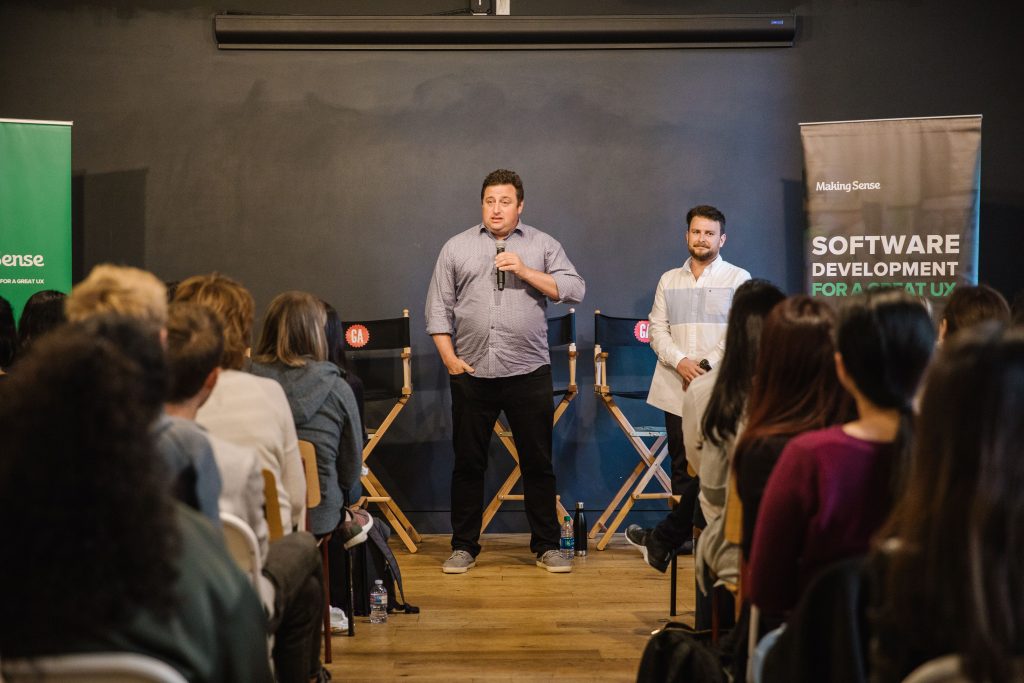This is our third UX-themed Meetup, this time hosted at General Assembly (GA). Making Sense has been working with GA for almost two years, in a partnership that benefits both sides. Today, we discussed the main challenges that experts in the field are facing as well as related concerns like using data and what makes a great UXer.
The speakers:
- Micah Alpern, Design Director at PayPal
- Yasmine Evjen, Senior Design Advocate at Google
- Xiaodan Wang, Director, Product Design at Facebook
- Moderator: Santiago Tribiani, Head UX at Making Sense
Here are some highlights of the discussion that took place with the panelists that were kind enough to offer their time to our latest Meetup.
Attributes that are Key in the UX Profession
UXers emerge from all types of backgrounds but the key attributes they seem to share are:
- Humbleness. You have to be confident in yourself as a manager in order to be humble.
- Helpfulness. “How can I help you to reach your goal?” Help people discover their strengths and build what the customer wants.
- Curiosity. UXers are curious about the problem the team has been given and how the process works.
- Passion. Being passionate is valuable because you can learn a skill but passion is from within.
- Communication and collaboration. These attributes are especially important for designers because there are so many stakeholders on any given job. You need to be able to build instant connections with the people you’re working with. You need to keep everyone updated. You need to be able to work with everyone, which means making compromises and trade-offs. It also means learning how to communicate your design ideas because there are so many people to convince. Podcasting is helpful in polishing your presentation skills. Anything that lets you practice your communication skills will help.
- Flexibility. You have to be able to go in all sorts of directions.
The Importance of Cross-Functional Teams
First of all, every company is different. Solutions have to be created which take into account company culture, goals, challenges, stakeholders, etc, and those are different for every company, every job.
However, the common denominator, the glue that makes everything stick no matter what type of customer you have, is team collaboration. Having everyone involved, representing a variety of backgrounds and opinions, is what makes a successful product. Cross-functional teams are the ideal situation because you have a great diversity of opinions and perspectives.
Cross-functional teams can sometimes be easier to achieve in larger development companies because there’s an opportunity to move within a company. This creates a sense of cohesion. A good tip for leaders is to make sure you’re moving people around — it’s beneficial to the company. Ossified teams are not conducive to building successful products.
In product development, both are true.
“If you want to go fast, go with a small group. If you want to go far, go with a large group.”
Micah Alpern, Design Director at PayPal
What It’s Like Being a Design Advocate at Google
Yasmine, Design Advocate at Google, brought his thoughts on this topic: “Design advocates represent the needs and opinions of designers both inside and outside the company. In our job, we may play many different roles. The day-to-day change is drastic. What helps is being agile.”
If you require a set schedule then it might not be the job for you. If you like to do different things every day and have a wide variety of responsibilities, this is the job for you.
UXers Must the Data Alive for Others
It’s helpful to look at problems from different angles. The data is how you do that. You can extract insights from data. Collect data from as many sources as you can. Strategic data, operational data, analytical data, etc. It’s helpful to create a visual map. Literally, a map! Put post-its on it and use it in your discovery process.
The landscape of the problem. How much is the company growing? Then there’s operational data, like how long are the servers down? Who’s using the product and why? How does the product work? Don’t let the only definition of your product be found just in the source code. UX designers translate that into a language that people can understand by mapping it out, providing use cases, etc. In this way, data is like a flashlight. It helps you see what’s going on. UXers use all this to tell stories and make everything come alive for everyone on a cross-functional team.
Data scientists have amazing knowledge but can’t easily communicate that information to others because they use a technical language. As a UX leader, you have to understand the technical language and bridge that gap, making the data comprehensible and digestible for the whole team. In short, you will be using both the left and right brain skills that you have.
“Design advocates represent the needs and opinions of designers both inside and outside the company.”
Yasmine Evjen, Design advocate at Google
Working With International Teams
People are people but cultures and norms have an impact on the UXer’s job. An international team can benefit from knowing about the special issues and concerns of designing for a customer who lives halfway across the world.
One of the main advantages to being close to your customer is that it helps with empathy. Developers and designers can look deeper into the world of the user and develop a product that suits them in the place where they live, work, and play. These principles come into play with a ride-share app, as pointed out by Xiaodan. Weather, crowds, congestion, and more locally-specific factors have a huge impact on how such an app would be developed.
Tips From the Pros
- Be rigorous. This means, in Xiaodan’s words, “be reliable, be hardworking, do more than you need to, never rest your mind, always be thinking”, and be the best in your class.
- Interact. Interact a lot with your community. When you’re first starting out, try different things (visual design vs interaction, for example). There are a lot of different UX jobs so explore all your options.
- Network. Find other passionate people and connect with them.
- Experiment. Take an existing product and take it apart. Explore the details and learn how it was made.
- Practice. Keep trying, learn from what’s already been done, and work to improve your work every time.
- Be persistent. Don’t let others derail your career goals. Stay focused on your goals and what you want to achieve.
“Be reliable, be hardworking, do more than you need to, never rest your mind, always be thinking
Xiaodan Wang, Director, Product Design at Facebook
Wrap-Up to the Meetup
Thanks again to the amazing group of panelists in our latest Meetup. By allowing everyone a glimpse into their distinguished careers at the global companies where they work, they are strengthening the UX community — something that benefits us all!
Let’s keep in touch for the next Meetup!
Wondering when our next meetup will be? Join our Meetup.com group, and keep posted with the latest news. We hope to see you again in future events, and if you have never attended, we would love to have you in our audience next time.
In the meantime, here’s the video of our meetup. Take a look at it!
See our photo album, you might appear in one pic :)

